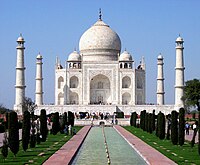| Nagina Mosque | |
|---|---|
 The mosque in 2008 | |
| Religion | |
| Affiliation | Sunni Islam |
| Ecclesiastical or organisational status | Mosque |
| Status | Active[ clarification needed ] |
| Location | |
| Location | Agra Fort, Agra, Uttar Pradesh |
| Country | India |
Location of the mosque in Uttar Pradesh | |
| Administration | Archaeological Survey of India |
| Geographic coordinates | 27°10′46″N78°01′21″E / 27.17944°N 78.02250°E |
| Architecture | |
| Type | Mosque architecture |
| Style | Mughal |
| Founder | Shah Jahan |
| Completed | c. 1631-1640 CE |
| Specifications | |
| Length | 7.39 m (24.2 ft) |
| Width | 10.21 m (33.5 ft) |
| Dome(s) | Three |
| Materials | Marble |
| Official name | Agra Fort: Nagina Masjid |
| Part of | Agra Fort |
| Reference no. | N-UP-A1-u |
| Official name | Agra Fort |
| Criteria | Cultural: (iii) |
| Reference | 251 |
| Inscription | 1984 (8th Session) |
 Location of the mosque in Agra Fort Location of the mosque in Agra Fort | |
The Nagina Masjid, also known as the Gem Mosque and the Jewel Mosque, [a] is a Sunni mosque, situated in the Agra Fort, a UNESCO World Heritage Site, located in Agra, in the state of Uttar Pradesh, India. The mosque was built by Shah Jahan, a Mughal leader, in c. 1631-1640 CE.
Contents
The mosque is a Monument of National Importance, administered by the Archaeological Survey of India. [1]

